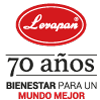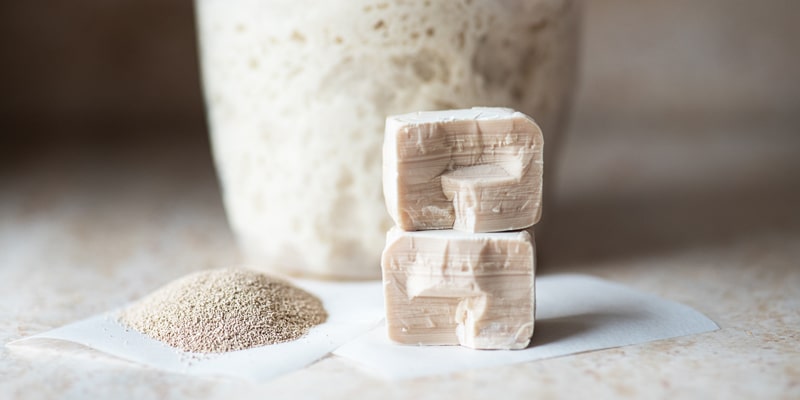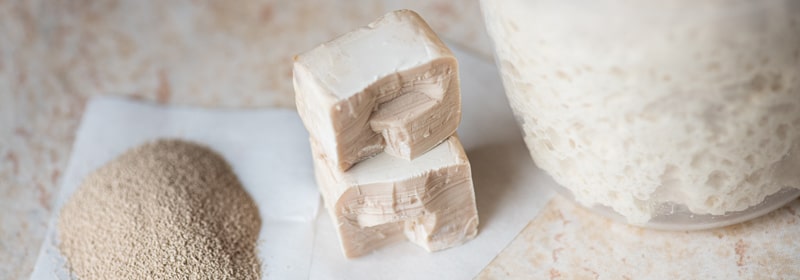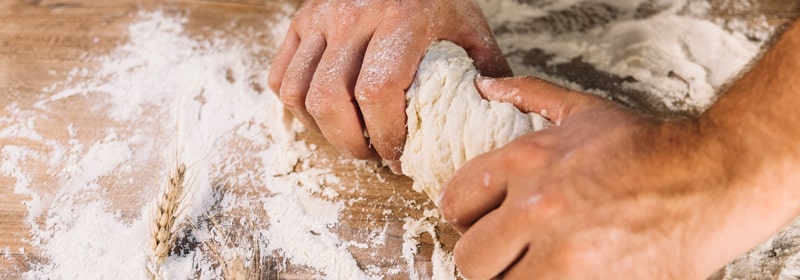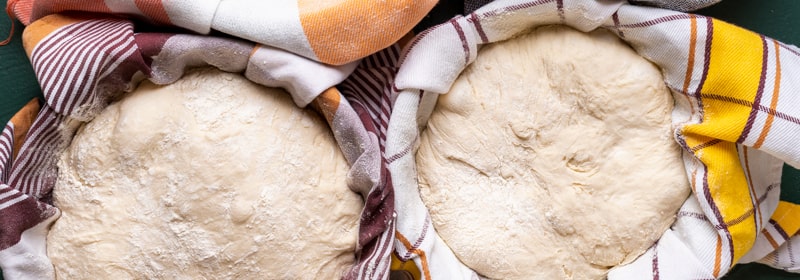Let’s start by understanding what yeast is. Yeast is a fungus that produces enzymes to convert sugars into alcoholic fermentations is able to convert sugar or carbohydrates, into important substances and nutrients for the body. The yeast acts on the doughs increasing their volume and giving them flavor and sponginess.
Biological yeast is a unicellular living microorganism known as SACCHAROMYCES CEREVISIAE (sugar fungus), which has the capacity to produce gas through the transformation of available sugars which helps us to increase the doughs their volume to later be baked.
Types of yeast:
Yeast is mainly used in the bakery for the preparation of doughs, it can also be used in pastry processes or those products that need to be leavened. Since as mentioned the objective of the yeast is to grow the doughs giving more volume before entering the oven.
You will then be able to differentiate the types of yeast you can find on the market.
Sourdough
It is natural yeast, which must be created from scratch. For its preparation, equal amounts of flour and water are mixed, leaving it to rest for 5 days until it ferments , an excessive time can generate damage to the sourdough, on fermentations and unwanted flavors. After this process it can be used for the preparation of sourdough bread.
Chemical yeast (baking powder):
The term chemical yeast is commonly used in other countries, but refers to baking powder or baking soda, this yeast is a chemical or gasifying driver that, when in contact with water, generates bubbles that make the dough fluffy. It is commonly used in pastry products.
It is produced artificially so it is not a biological agent. What we are looking for in this article is to compare strawberry yeast and instant dry yeast, both of which are biological agents.
instant dry yeast
It is a fresh yeast drying technology. It is dried in a similar way to dry active yeast and then vacuum packed, which allows it to last 2 years with the packaging closed and in optimal conditions, once opened the product only lasts 72 hours.
During this drying process between 35°C and 40°C the yeast suffers, weakens and approximately 18% of yeast cells die.
For its activation you must dilute it in warm water and then add it to the dough, either to prepare bread, pizza, empanadas or other similar doughs for various products of your bakery and pastry. This process corresponds to dry active yeast, because instant dry yeast is incorporated directly onto the flour.
Fresh Yeast
It is a 100% natural and fresh product, you can find it pressed in block. When asked how fresh yeast should be preserved; We recommend always keeping it in the fridge in a container with a hermetic closure because it has a wet consistency that can be damaged by sudden changes in temperature or when in contact with other substances.
In the bakery world it is very common to make equivalences between fresh and dry yeast depending on the preparation of bread that you want to make, then we share the table of equivalences between yeasts.
How much does fresh yeast equal to dry?
When preparing a recipe, it is important to pay attention to the amounts indicated, so you should take into account this picture that we will share.
Table of equivalences between fresh and dried yeast:
Fresh yeast |
Instant dry yeast |
14 g |
5’5 gr |
42 g |
16 g |
To calculate the amount of yeast in equivalent portions, you need to use a rule of three. For example, in equivalence 3 to 1 of fresh yeast by dry yeast its equivalent should be 9 grams. If it is 2.5 to 1 its equivalence is 7.5 grams. On the other hand, if the recipe does not specify the type of yeast or if quantities greater than 15 grams are required for its preparation, you should safely use fresh yeast.
What is the best option for your bakery?
Both fresh and dried yeast are fully functional to make all kinds of bread for your business, however, if you want quality in your products, our recommendation is that you use
fresh yeast Levapan
In most of its preparations, which will give a greater volume, performance and quality to each of its preparations.
Additionally we want to tell you some disadvantages of using instant dry yeast that make fresh yeast your best choice:
- Instant dry yeast is not easily distributed in the dough.
- The instant dry yeast must be placed at the beginning of kneading.
- It is less favorable in the taste, aroma and freshness of bread made with instant dry yeast vs. breads prepared with fresh yeast.
- Breads made with instant yeast will feel drier.
- The mass obtained from instant dry yeast is weaker.
- The crust of instant dry yeast breads tends to be thicker.
5 tips to use fresh yeast correctly
- Keep it refrigerated at a temperature between 0 ° C to 5 ° C, we recommend gradually remove the yeast you are going to use from the cold room.
- Fresh yeast is the most suitable for working in cold doughs. In frozen doughs it does not require any special treatment, only increase the % of dosage.
- You need to take into account the manufacturing date and expiration date of the fresh yeast. We recommend rotating your inventory according to these dates.
- Do not mix the salt together with the fresh yeast.
- Add the fresh yeast at the beginning or end of kneading depending on the force you want to obtain in the dough.
Between 0 and 8°C |
Sleep (Storage) |
Between 9 and 16°C |
Wakes up (kneading process) |
17 and 26°C |
Search for food (Forming Process) |
Between 27 and 35°C |
Works (Fermentation Chamber) |
55 and 60°C |
It weakens and dies (Jump of oven) |
Following these tips, we are sure you will be able to strengthen and retain your customers.
Levapan fresh yeast
will ensure that you always maintain the high quality of your products and the results will be second to none.
